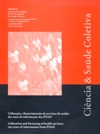0380/2009 - Cárie dental e estado nutricional de pré-escolares – análise espacial
Dental caries and nutritional status of preschool children – spatial analysis
Author:
• Juliana Alvares Duarte Bonini Campos - Campos, J. A. D. B. - Araraquara - Faculdade de Odontologia de Araraquara - UNESP - <juliana.campos@unesp.br>ORCID: https://orcid.org/0000-0001-7123-5585
Thematic Area:
Não CategorizadoAbstract:
Objective: This cross-sectional study aims to spatially analyze the distribution of dental caries and nutritional status (NS) of 5-year-old preschool children of public schools in the city of Araraquara, SP, Brazil. Methods: The sample was selected in a probabilistic stratified manner. A dental examination was conducted to investigate the dmft index. The anthropometric indicators of the weight/height (W/H), height/age (H/A), weight/age (W/A) and body mass index (BMI) were calculated to estimate the NS. A statistical descriptive analysis was conducted and a thematic map was created. At the end of the study 491 children had a complete address codification. A GPS device was used to capture the geographic referential points. An omini-directional semivariogram was elaborated. Results: According to the results, it was observed that both variables presented a pure nugget effect showing the absence of a spatial correlation, that is, the dmft and nutritional status are not regionalized variables, and its values do not present direct spatial dependence. Conclusions: Dental caries and nutritional status are health conditions that do not present direct spatial dependence. Ultimately, the combination of these indicators with others can produce spatial dependent effects.Key Words: Anthropometry, Dental caries, Geostatistic, Nutritional State, Spatial Analysis.











